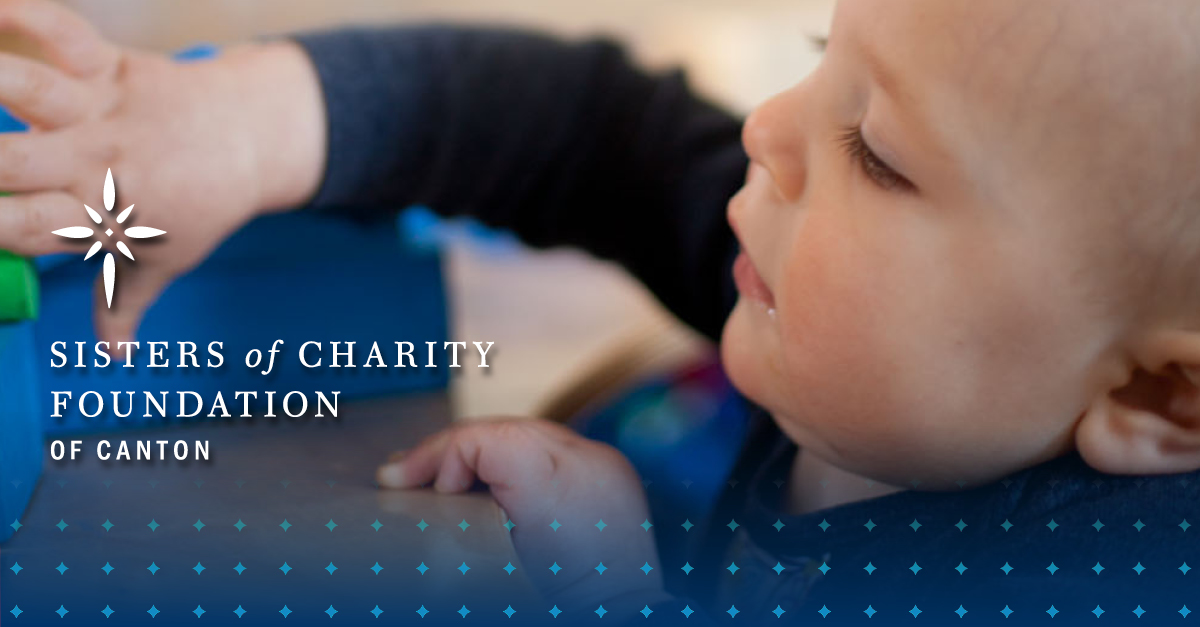Sisters of Charity Foundation of Canton provides support to Stark County initiative working to reduce infant mortality

Toward Health Resiliency for Infant Vitality and Equity (THRIVE) is a collaborative of Stark County residents, community organizations/agencies—including the Sisters of Charity Foundation of Canton—and businesses focused on preventing and reducing infant death rates and disparities in birth outcomes. The initiative has made strides toward reducing infant mortality in the county, as reported by The Canton Repository and WKSU.org.
The full text of The Canton Repository article is below. The Sisters of Charity Foundation of Canton is a ministry of the Sisters of Charity Health System.
Stark initiative helps boost county’s live births total
By Denise Sautters
April 2, 2018
The good news is more babies are surviving infancy. The bad news is there is more work to be done.
Toward Health Resiliency for Infant Vitality and Equity (THRIVE) is a collaborative of Stark County residents, community organizations/agencies and businesses focused on preventing and reducing infant death rates and disparities in birth outcomes.
Stark County experienced some positive signs between 2015 and 2016, according to Dawn Miller, project manager from the Canton City Health Department.
Those include: A 10 percent increase in the number of pregnant African American women who entered prenatal care within the first trimester; a decrease in smoking in the third trimester among all pregnant women; and a 5 percent reduction in the number of teen births.
In 2016, the infant mortality rate was 9.0, meaning nine of every 1,000 babies born in Stark County in 2016 died, Miller said.
While the overall rate was slightly higher in 2017 at 9.3, there was improvement among black infants — 21.0 in 2016 compared to 17.5 in 2017. The white infant death rate was 7.7 in 2016 and 8.5 in 2017. The disparity rate between black and white babies was 2.7 in 2016 and 2.1 in 2017, an improvement over previous years.
The disparity rate means that in 2016, nearly three black babies died for every white baby that died.
“Our goal is to decrease the disparity rate by 1.0,” she said. “We saw improvement from 2016 to 2017, as the disparity rate dropped to two black babies dying for every one white baby that died.”
Numbers analysis
“I look at all of the deaths as a whole,” said Annie Butusov, an epidemiologist and fetal infant mortality review board coordinator. “We gather records for every single baby who dies in Stark County and birth, hospital and pediatrician records, mom’s obstetrician records, any social history, police records, Job and Family Services and if the parents are married or living together.
“We gather the same information for the father, and we take a look at the family as a whole to see trends, things that are common in the families that have passed away, and we look at the death of children who are born alive.”
If the baby inhales air and dies on the exhale, it is considered a live birth, she said. As a group, the agency tries to decide what deaths were preventable.
“When we determine if the death was preventable, we make recommendations on how to prevent the death in the future,” said Butusov.
New parents should follow the ABCs of babies developed by the American Academy of Pediatrics:
A: They should sleep alone. This means no stuffed animals, no toys, no blankets, no pillows, no pets, no sleeping with parents or other children. Just the baby, in a sheet, on a firm mattress. Butusov recommends swaddling.
B: Babies should always sleep on their backs. The windpipe faces upward and you want to leave that open. In addition, the baby should face alternate directions in their crib, one night facing right, the next facing left. The room should be kept smoke free.
C: Babies should always sleep in a crib, bassinet or in a Pack n’ Play.
Environment matters
Education and the environment have a lot to do with providing a safe environment for a baby, according to Miller.
“Socially, your health depends on where you live,” said Miller. “Place matters. Are you educated? Do you need and are receiving mental health services? Are you employed? Do you have stress? Health insurance? Stable housing? Good housing? Running water? Heat? Free from pests and rodents? Do you have a working stove and refrigerator? Access to care?”
Part of the problem is many mothers do not receive prenatal care, an issue THRIVE is working to address.
“We have secured funds from state and local funders, Medicaid dollars, Sisters of Charity Foundation of Canton, United Way of Greater Stark County, and the Stark County Community Foundation, which are working together to make THRIVE successful,” said Miller.
One way is by providing community workers who serve as support persons to families by linking the families to the support groups they need. Now, clients are getting the resources they need. THRIVE is using Pathways Community Hub, a system of documenting outcomes and care coordination.
The goal: To make sure all babies reach their first birthday.

- Sisters of Charity Health System
- News Releases
- St. Vincent Charity Health Campus
- Light of Hearts Villa
- Regina Health Center
- Sisters of Charity Foundation of Canton
- Sisters of Charity Foundation of Cleveland
- Sisters of Charity Foundation of South Carolina
- Building Healthy Communities
- Catholic Community Connection
- Early Childhood Resource Center
- Healthy Learners
- Joseph and Mary's Home
- South Carolina Center for Fathers and Families